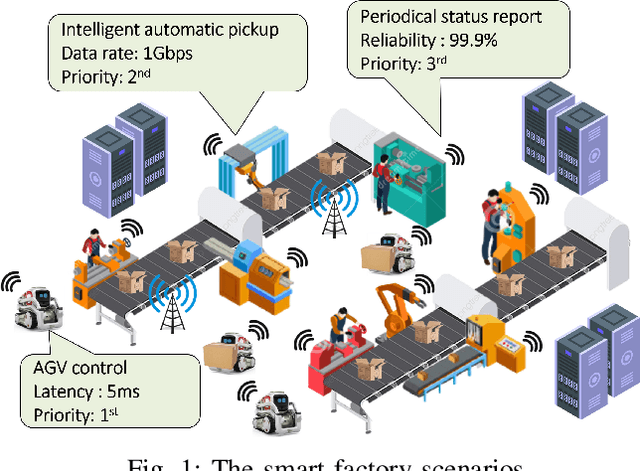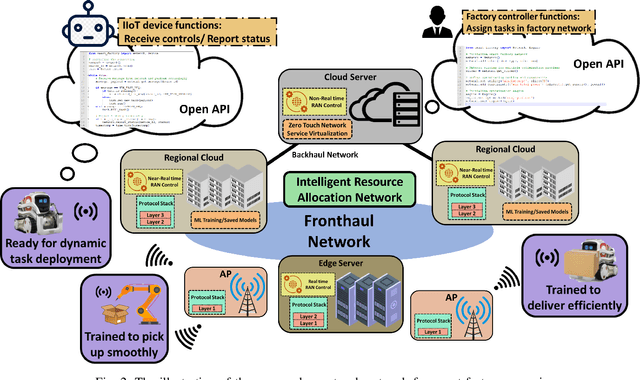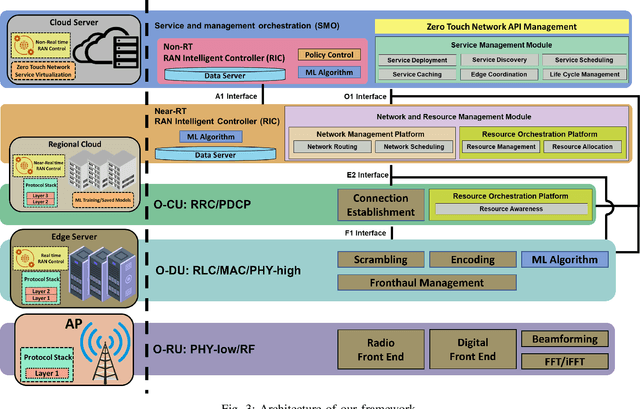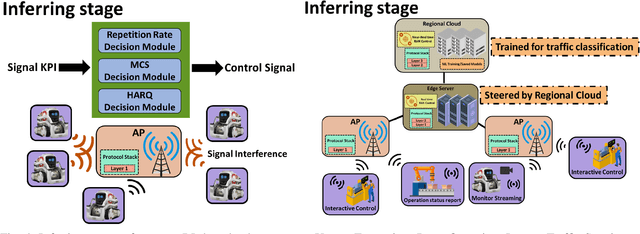Shih-Chun Lin
FedAuxHMTL: Federated Auxiliary Hard-Parameter Sharing Multi-Task Learning for Network Edge Traffic Classification
Apr 11, 2024Abstract:Federated Learning (FL) has garnered significant interest recently due to its potential as an effective solution for tackling many challenges in diverse application scenarios, for example, data privacy in network edge traffic classification. Despite its recognized advantages, FL encounters obstacles linked to statistical data heterogeneity and labeled data scarcity during the training of single-task models for machine learning-based traffic classification, leading to hindered learning performance. In response to these challenges, adopting a hard-parameter sharing multi-task learning model with auxiliary tasks proves to be a suitable approach. Such a model has the capability to reduce communication and computation costs, navigate statistical complexities inherent in FL contexts, and overcome labeled data scarcity by leveraging knowledge derived from interconnected auxiliary tasks. This paper introduces a new framework for federated auxiliary hard-parameter sharing multi-task learning, namely, FedAuxHMTL. The introduced framework incorporates model parameter exchanges between edge server and base stations, enabling base stations from distributed areas to participate in the FedAuxHMTL process and enhance the learning performance of the main task-network edge traffic classification. Empirical experiments are conducted to validate and demonstrate the FedAuxHMTL's effectiveness in terms of accuracy, total global loss, communication costs, computing time, and energy consumption compared to its counterparts.
6G-AUTOR: Autonomic CSI-Free Transceiver via Realtime On-Device Signal Analytics
Jun 07, 2022



Abstract:Next-generation wireless systems aim at fulfilling diverse application requirements but fundamentally rely on point-to-point transmission qualities. Aligning with recent AI-enabled wireless implementations, this paper introduces autonomic radios, 6G-AUTOR, that leverage novel algorithm-hardware separation platforms, softwarization of transmission (TX) and reception (RX) operations, and automatic reconfiguration of RF frontends, to support link performance and resilience. As a comprehensive transceiver solution, our design encompasses several ML-driven models, each enhancing a specific aspect of either TX or RX, leading to robust transceiver operation under tight constraints of future wireless systems. A data-driven radio management module was developed via deep Q-networks to support fast-reconfiguration of TX resource blocks (RB) and proactive multi-agent access. Also, a ResNet-inspired fast-beamforming solution was employed to enable robust communication to multiple receivers over the same RB, which has potential applications in realisation of cell-free infrastructures. As a receiver the system was equipped with a capability of ultra-broadband spectrum recognition. Apart from this, a fundamental tool - automatic modulation classification (AMC) which involves a complex correntropy extraction, followed by a convolutional neural network (CNN)-based classification, and a deep learning-based LDPC decoder were added to improve the reception quality and radio performance. Simulations of individual algorithms demonstrate that under appropriate training, each of the corresponding radio functions have either outperformed or have performed on-par with the benchmark solutions.
Zero-Touch Network on Industrial IoT: An End-to-End Machine Learning Approach
Apr 26, 2022



Abstract:Industry 4.0-enabled smart factory is expected to realize the next revolution for manufacturers. Although artificial intelligence (AI) technologies have improved productivity, current use cases belong to small-scale and single-task operations. To unbound the potential of smart factory, this paper develops zero-touch network systems for intelligent manufacturing and facilitates distributed AI applications in both training and inferring stages in a large-scale manner. The open radio access network (O-RAN) architecture is first introduced for the zero-touch platform to enable globally controlling communications and computation infrastructure capability in the field. The designed serverless framework allows intelligent and efficient learning assignments and resource allocations. Hence, requested learning tasks can be assigned to appropriate robots, and the underlying infrastructure can be used to support the learning tasks without expert knowledge. Moreover, due to the proposed network system's flexibility, powerful AI-enabled networking algorithms can be utilized to ensure service-level agreements and superior performances for factory workloads. Finally, three open research directions of backward compatibility, end-to-end enhancements, and cybersecurity are discussed for zero-touch smart factory.
Privacy-Preserving Serverless Edge Learning with Decentralized Small Data
Dec 01, 2021



Abstract:In the last decade, data-driven algorithms outperformed traditional optimization-based algorithms in many research areas, such as computer vision, natural language processing, etc. However, extensive data usages bring a new challenge or even threat to deep learning algorithms, i.e., privacy-preserving. Distributed training strategies have recently become a promising approach to ensure data privacy when training deep models. This paper extends conventional serverless platforms with serverless edge learning architectures and provides an efficient distributed training framework from the networking perspective. This framework dynamically orchestrates available resources among heterogeneous physical units to efficiently fulfill deep learning objectives. The design jointly considers learning task requests and underlying infrastructure heterogeneity, including last-mile transmissions, computation abilities of mobile devices, edge and cloud computing centers, and devices battery status. Furthermore, to significantly reduce distributed training overheads, small-scale data training is proposed by integrating with a general, simple data classifier. This low-load enhancement can seamlessly work with various distributed deep models to improve communications and computation efficiencies during the training phase. Finally, open challenges and future research directions encourage the research community to develop efficient distributed deep learning techniques.
Vehicular Network Slicing for Reliable Access and Deadline-Constrained Data Offloading: A Multi-Agent On-Device Learning Approach
Dec 31, 2020



Abstract:Efficient data offloading plays a pivotal role in computational-intensive platforms as data rate over wireless channels is fundamentally limited. On top of that, high mobility adds an extra burden in vehicular edge networks (VENs), bolstering the desire for efficient user-centric solutions. Therefore, unlike the legacy inflexible network-centric approach, this paper exploits a software-defined flexible, open, and programmable networking platform for an efficient user-centric, fast, reliable, and deadline-constrained offloading solution in VENs. In the proposed model, each active vehicle user (VU) is served from multiple low-powered access points (APs) by creating a noble virtual cell (VC). A joint node association, power allocation, and distributed resource allocation problem is formulated. As centralized learning is not practical in many real-world problems, following the distributed nature of autonomous VUs, each VU is considered an edge learning agent. To that end, considering practical location-aware node associations, a joint radio and power resource allocation non-cooperative stochastic game is formulated. Leveraging reinforcement learning's (RL) efficacy, a multi-agent RL (MARL) solution is proposed where the edge learners aim to learn the Nash equilibrium (NE) strategies to solve the game efficiently. Besides, real-world map data, with a practical microscopic mobility model, are used for the simulation. Results suggest that the proposed user-centric approach can deliver remarkable performances in VENs. Moreover, the proposed MARL solution delivers near-optimal performances with approximately 3% collision probabilities in case of distributed random access in the uplink.
 Add to Chrome
Add to Chrome Add to Firefox
Add to Firefox Add to Edge
Add to Edge